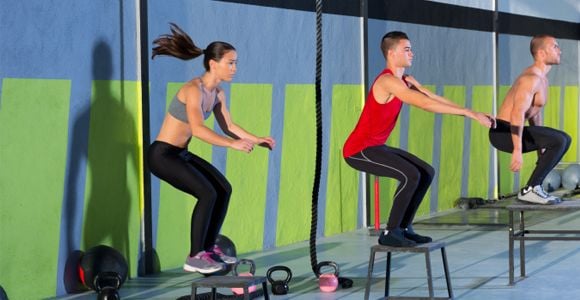A brand new training technique that involves power jumping has breached the surface of hardcore exercise regimens among athletes and fitness experts nationwide. Okay, it's not that new. It was actually developed in the 1970's, but the high-intensity exertion rate that plyometric training forces on the body might be exactly what you need in order to burn off fat at an accelerated rate in order to reach your fitness goals. If you're unfamiliar with plyometric training, how it works and why it works, it's time to elevate your knowledge.
What Is Plyometric Training?
The concept of plyometric training is simple: condition the body with intense bouts of resistance exercise that stretch and contract major muscle groups. Sounds familiar, right? That is essentially the process that takes place when you lift weights.
This increasingly popular training technique was originally designed for Olympic athletes, but can be incorporated into your exercise routine. Consult a physician if you are unsure if you are healthy enough for high-intensity modes of exercise, such as plyometric training, as this could lead to injury.
Benefits of Plyometric Training
The fitness benefits of power jumping are bountiful, applicable to the movements performed in several sports, like basketball, football and volleyball. One of the primary benefits of plyometric exercise is exactly that: sport-specific training. In addition, the American Council on Exercise reveals that plyometric training improves vertical leaping ability, muscular strength and joint and tendon flexibility. The American Council on Exercise also recommends proceeding with caution when participating in plyometric training, as injury is a predominant risk.
Why Plyometric Training Works
Plyometric training has been scientifically tested to improve strength throughout the body in participants as young as 12, according to the Journal of Sports Science and Medicine (2007).
Furthermore, research suggests that multi-component exercise programs, such as plyometric training, are effective because proper execution requires the body to work in unison. This differs from weightlifting in that a single lifting exercise typically focuses energy on a particular major muscle group, as opposed to the entire body.
Plyometric training combines the rigor of cardiovascular exercise with the strain of weightlifting, which maximizes calorie burn, thus increasing participants' ability to gain strength and lose weight.
Start with the Basics
Plyometric training is most frequently linked to Tony Horton's P90X, a rigorous 90-day workout program designed to maximize your athletic performance and physical fitness level.
You should not immediately incorporate high-level plyometric exercises in your workout routine. It's important to practice your technique before engaging high-level exercises in order to ensure safety. The most basic plyometric exercises are the vertical jump and giant leap.
Plyometric Training for Beginners
To perform a vertical jump, simply stand in place with your feet shoulder-length apart, bend your knees while keeping your arms slightly bent, and leap directly upward. Frequent repetition of this exercise will work the muscles in your legs and core.
A giant leap, also referred to as "steps and bounds," is basically a stretched-out skipping motion. To practice the giant leap, assume a standard upright jogging motion, take a few strides forward on a flat running surface, and rotate between leaping off your left foot and right foot.
These basic exercises with help acclimate you to plyometric training while also improving your technique. You'll be an expert faster than you might think.

John Shea is a team sports fanatic and fitness aficionado. His work has been published across a wide platform of online audiences in the realm of health and fitness. His passion for fitness is exemplified in his writing, as he aims to help readers improve their overall well-being.



